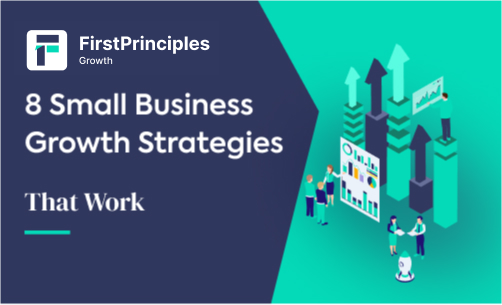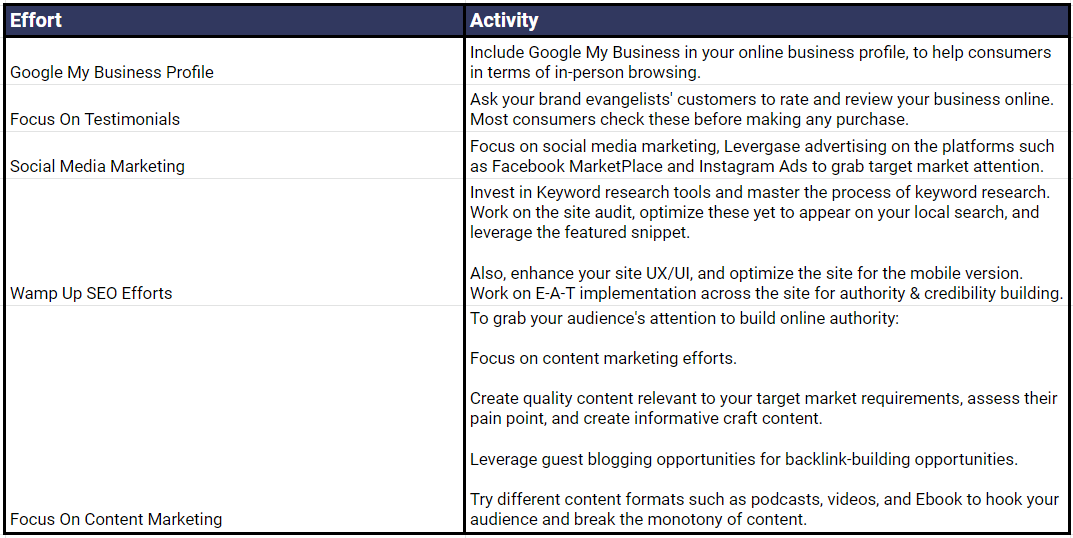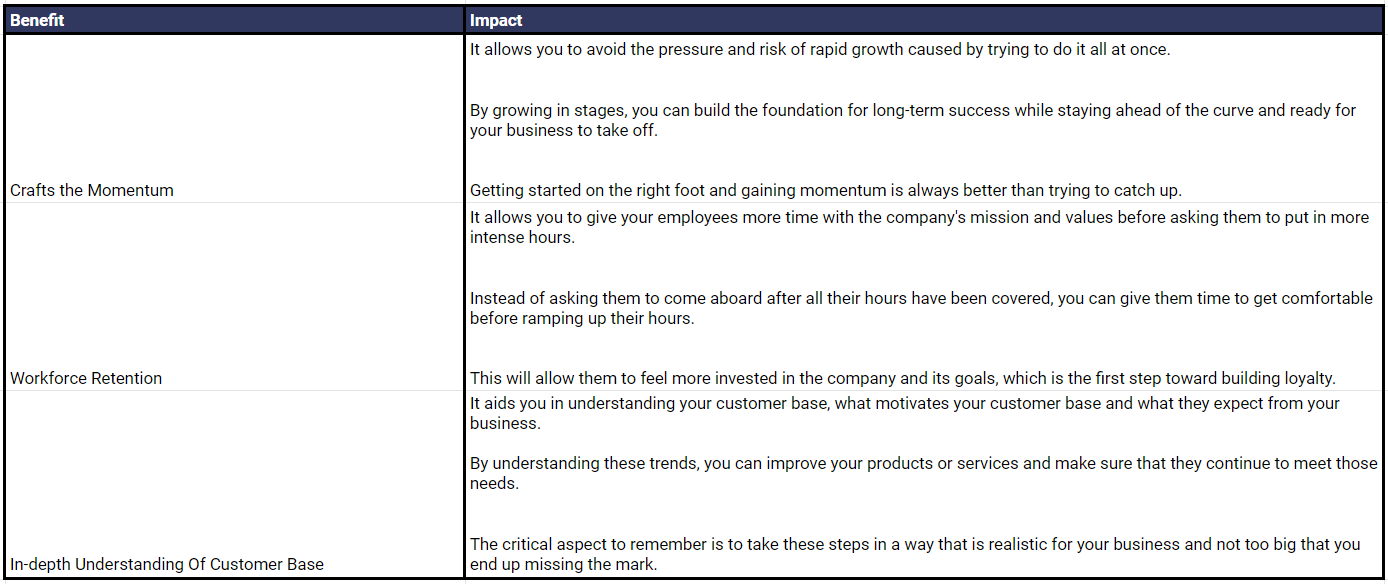
Home > 8 Small Business Growth Strategies that Work
Table of Contents
ToggleWith increased competition and a growing digital landscape, the threshold for succeeding in business is higher than ever before. However, there’s hope on the horizon for small businesses looking to scale. The answer lies in the strategies that work for other growing enterprises. Adhering to the compelling small business growth strategies that will help you achieve your goals and breakthrough in the new year.
Data says, there are 32.5 million small businesses in the US.[Source] The industry also has an influential impact on the labor market. Small firms account for 64% of all job creation in the United States and employ 1.5 million people annually. [Source]
Today’s business environment is more crowded and competitive than ever before. This means small businesses need to take a step back, reevaluate their current strategies and adopt new ones. Small businesses are forced to think outside the box to grow their businesses.
With increasing competition, small business owners often struggle to get the proper traction in their respective fields. If you run a small business and are looking for ways to grow your business, we have encased the business strategies for sustainable growth work in 2023 in this blog. Let’s read on.
Small business growth strategies are a vital part of business success. Yet, it can be challenging for many to know where to begin when it comes to growing their business. Diverse factors go into running a successful small business, from choosing the right location and working with local vendors and service providers to drafting a solid operating plan and creating an effective marketing strategy.
However, with continued research and testing, we’ve identified nine proven strategies that will increase your small business growth rate in the years ahead. Read on to know more about the tactics and how they can help your small business succeed in the coming months and years.
An online presence is imperative for future success, even if your business is flourishing. Even if your physical business is thriving, having a digital presence is critical for future success. As the SaaS space grows exponentially in the years and decades to come, even if you’re dependent on in-person visits, are not expected to see a slowdown.
Drilling the data on digital marketing, it is derived that digital marketing is anticipated to increase at a compound annual growth rate of 9% from 2020 to 2026.[Source] The proportion of companies with increased digital marketing budgets rose to 63% [Source] Between 2020 and 2023, there was a 14% growth in digital marketing budget spending across businesses [Source]
Digital presence with social media is your reliable companion when customers can’t find your business in person; in fact, with the current rise of social media marketing, social media should be used to stay top of mind. In addition, research has shown that 97% of consumers now rely on online media to research products and services in their local area [Source]. To fuel up your online presence pump up the following efforts:

It is a formal process that helps an organization understand the environment in which it operates, the current state of its business, and the drivers of change that influence its success. It enables businesses to make wise decisions about their future and create a vision of where it is going.
Before expanding your business beyond its current structure, you should conduct a business analysis. This allows businesses to identify key pain points within their business and make adjustments that can help to reduce those pain points.
Hiring in-demand talent is a crucial growth strategy for businesses due to its dual benefits. On the one hand, it helps companies to attract and retain top talent. On the other hand, it also helps them achieve their hiring objectives faster and more effectively.
Every successful business grows by creating strong partnerships with other businesses in their industry as well as some non-traditional partners. By partnering with other businesses in the industry, you can help to expand your client base. It is crucial because the tactic allows you to expand the types of clients that you serve. This can help increase the size of your revenue stream and expand the types of clients you serve.
In the years ahead, more companies are expected to form collaborative partnerships with other businesses. These partnerships are designed to help both parties achieve their goals and increase their bottom lines.

[Image Source: Influencer Marketing Hub
Successful businesses thrive on feedback. It helps to identify key pain points within your business and make adjustments that can help to reduce those pain points.
Setting up a precise, accessible, and continuous feedback loop with your clients, vendors, and employees can help to reduce the risk of making mistakes in your business as well. This is because it allows you to prevent mistakes before they become large-scale problems. Note that many small businesses grow when they make adjustments within their business rather than make significant changes to their core functionality.

[Image Source: Sam Houston State University]
Successful small businesses grow in stages. This can be beneficial because it allows businesses to take smaller steps while growing instead of all at once. It enables businesses to identify key pain points within their business and make adjustments that can help to reduce those pain points. Let’s check out the benefit of growth in stages:

Diversifying your business can help protect against economic downturns and increase your bottom line. By incorporating a range of products and services, you can provide an array of products and services to your customers, thereby improving your revenue and profits. Additionally, diversification can help protect your business against a market crash or price war by offering a more diverse product line.
Before expanding your marketing budget, you should add up the upfront costs associated with marketing your product. This allows small businesses to identify key pain points within their marketing strategy and make adjustments that can help to reduce those pain points.
Don’t forget to understand the barriers to growth. As you begin to grow your business, you’ll likely discover that growth requires hard work and dedication. It also requires time and time spent focusing on growth opportunities.
In addition, customers’ demands for superior service should be given precedence in 2023. Be sure to go above and beyond to accommodate your clients, and ensure your employees are thoroughly trained to deliver the highest quality service.
Inculcating the business growth strategy is to retain outstanding personnel and increase company growth by establishing a strong business culture. Make an effort to have an open-door policy so employees can voice their concerns and connect with each other by being as transparent as possible. Also, to guarantee business survival, companies should endeavor to obtain adequate business insurance.
Ameet Mehta‘s expertise lies in building revenue engines for technology-enabled companies and private equity investments. He began his journey with TechStars Chicago and has since founded and acquired several companies through FirstPrinciples Holding Company. The FirstPrinciples portfolio generates over $7M in revenue/year with most companies in the SaaS space. He...